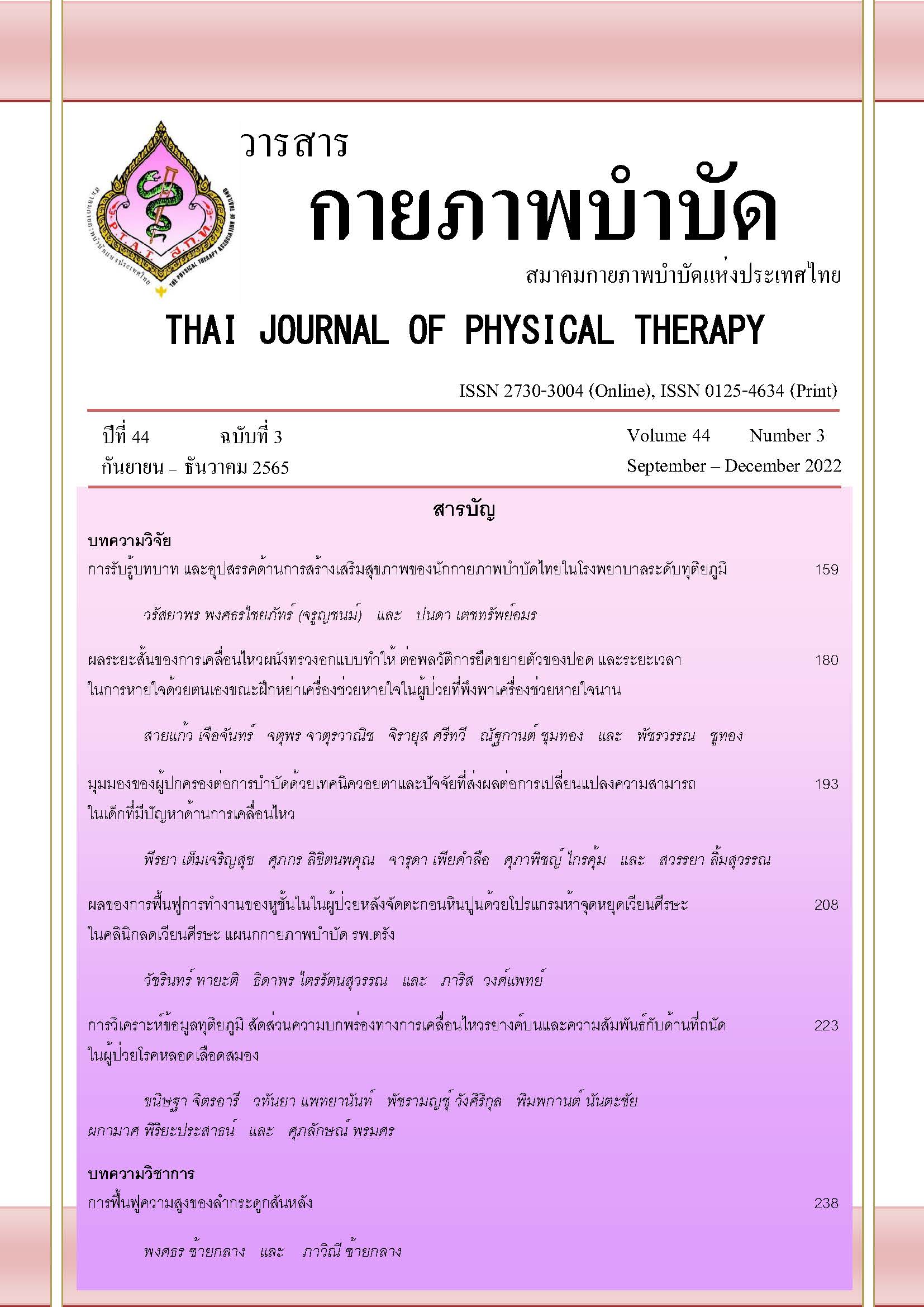ผลของการฟื้นฟูการทางานของหูชั้นในในผู้ป่วยหลังจัดตะกอนหินปูนด้วยโปรแกรม ห้าจุดหยุดเวียนศีรษะในคลินิกลดเวียนศีรษะ แผนกกายภาพบาบัด รพ.ตรัง
Main Article Content
บทคัดย่อ
ที่มาและความสาคัญ: การบริหารแบบ Modified Cawthorne Cooksey exercise (MCC) เป็นวิธีการมาตรฐาน เพื่อฟื้นฟูสมรรถภาพการทรงตัว (vestibular rehabilitation) ของผู้ป่วยโรคตะกอนหินปูนในหูชั้นในหลุด ภายหลังการจัดตะกอนหินปูนในคลินิกลดเวียนศีรษะ โรงพยาบาลตรัง แต่การปฏิบัติท่าบริหารดังกล่าวทาได้ยาก สาหรับผู้ป่วยที่มีปัญหาการใช้งานแขนและมือ ผู้วิจัยจึงได้ออกแบบวิธีการฝึกบริหารแบบใหม่ ที่ไม่ต้องใช้แขนในการฝึก เรียกว่า Five Points Hands Free (FPHF) ขึ้นมาใช้ทดแทน
วัตถุประสงค์: เพื่อศึกษาเปรียบเทียบประสิทธิภาพของการฟื้นฟูสมรรถภาพการทรงตัวด้วยการฝึกแบบ FPHF เปรียบเทียบกับแบบ MCC แบบ customized vestibular rehabilitation (CVR)
วิธีการวิจัย: วิเคราะห์ข้อมูลย้อนหลัง เปรียบเทียบการเปลี่ยนแปลงของผู้ป่วยโรคตะกอนหินปูนในหูชั้นในหลุด ก่อนและหลังการฟื้นฟูสมรรถภาพการทรงตัวด้วยการฝึกแบบ FPHF หรือ CVR ทาการประเมินระดับความรุนแรงของอาการเวียนศีรษะด้วยการประเมิน visual analogue scale (VAS) ประเมินความนิ่งของการกลอกตาด้วยการทดสอบ Gaze evoked nystagmus (GEN) และผลการทดสอบ Head impulse test (HIT)
ผลการวิจัย: ผู้ป่วยทั้งสองกลุ่มมีคะแนน VAS, HIT และ GEN ที่ดีขึ้นหลังรับการรักษาอย่างมีนัยสาคัญทางสถิตที่ค่า p < 0.01 เมื่อเทียบกับก่อนการรักษา อย่างไรก็ตามพบว่าผู้ป่วยกลุ่ม FPHF มีการเปลี่ยนแปลงของ คะแนน GEN ที่สูงกว่า กลุ่ม CVR อย่างมีนัยสาคัญทางสถิติ ที่ค่า p < 0.01
สรุปผล: การศึกษาแบบย้อนหลังนี้ พบว่า ฟื้นฟูการทางานของระบบการทรงตัว ด้วยวิธี FPHF ให้ผลเทียบเท่ากันกับวิธี CVR และอาจมีประสิทธิภาพที่ดีกว่าในด้านการฟื้นฟูเฉพาะด้านความนิ่งของการกลอกตาอีกด้วย
Article Details

อนุญาตภายใต้เงื่อนไข Creative Commons Attribution-NonCommercial-NoDerivatives 4.0 International License.
เอกสารอ้างอิง
Hülse R, Biesdorf A, Hörmann K, Stuck B, Erhart M, Hülse M, et al. Peripheral vestibular disorders: An epidemiologic survey in 70 million individuals: An epidemiologic survey in 70 million individuals. Otol Neurotol. 2019;40(1):88–95.
Tungvachirakul V, Lisnichuk H, O’Leary SJ. Epidemiology of vestibular vertigo in a neuro-otology clinic population in Thailand. J Laryngol Otol. 2014;128 Suppl 2(S2):S31-8.
Yetiser S. Review of the pathology underlying benign paroxysmal positional vertigo. J Int Med Res. 2020;48(4):300060519892370.
Giommetti G, Lapenna R, Panichi R, Mobaraki PD, Longari F, Ricci G, et al. Residual Dizziness after Successful Repositioning Maneuver for Idiopathic Benign Paroxysmal Positional Vertigo: A Review. Audiol Res. 2017;7(1):178.
Hall CD, Herdman SJ, Whitney SL, Cass SP, Clendaniel RA, Fife TD, et al. Vestibular Rehabilitation for Peripheral Vestibular Hypofunction: An Evidence-Based Clinical Practice Guideline: from the American physical therapy association neurology section. J Neurol Phys Ther. 2016;40(2):124-55.
Kulcu DG, Yanik B, Boynukalin S, Kurtais Y. Efficacy of a home-based exercise program on benign paroxysmal positional vertigo compared with betahistine. J Otolaryngol Head Neck Surg. 2008;37(3):373–9.
Hall CD, Heusel-Gillig L, Tusa RJ, Herdman SJ. Efficacy of gaze stability exercises in older adults with dizziness. J Neurol Phys Ther. 2010;34(2):64–9.
Meldrum D, Burrows L, Cakrt O, Kerkeni H, Lopez C, Tjernstrom F, et al. Vestibular rehabilitation in Europe: a survey of clinical and research practice. J Neurol. 2020;267(Suppl 1):24–35.
Toupet M, Ferrary E, Grayeli AB. Visual analog scale to assess vertigo and dizziness after repositioning maneuvers for benign paroxysmal positional vertigo. J Vestib Res. 2011;21(4):235-41.
Strupp M, Hüfner K, Sandmann R, Zwergal A, Dieterich M, Jahn K, et al. Central oculomotor disturbances and nystagmus: a window into the brainstem and cerebellum. Dtsch Arztebl Int. 2011;108(12):197–204.
Giommetti G, Lapenna R, Panichi R, Mobaraki PD, Longari F, Ricci G, et al. Residual dizziness after successful repositioning maneuver for idiopathic benign paroxysmal positional vertigo: A review. Audiol Res. 2017;7(1):178.
Whyte CA, Petrock AM, Rosenberg M. Occurrence of physiologic gaze-evoked nystagmus at small angles of gaze. Invest Ophthalmol Vis Sci. 2010;51(5):2476–8.
Schubert MC, Tusa RJ, Grine LE, Herdman SJ. Optimizing the sensitivity of the head thrust test for identifying vestibular hypofunction. Phys Ther. 2004;84(2):151-8.
Verrecchia L, Galle Barrett K, Karltorp E. The feasibility, validity and reliability of a child friendly vestibular assessment in infants and children candidates to cochlear implant. Int J Pediatr Otorhinolaryngol. 2020;135
Bunasuwan P. Vertigo Available from: http://www.med.tu.ac.th/UserFiles/File/ENT/sheet%20vertigo.pdf [cited 12 Sep 2021].
Herdman SJ, Clendaniel R. Vestibular Rehabilitation 4e. 4th ed. Philadelphia, PA: F.A. Davis Company; 2014.
Hegemann S, Straumann D, Bockisch C. Alexander’s law in patients with acute vestibular tone asymmetry--evidence for multiple horizontal neural integrators. J Assoc Res Otolaryngol. 2007;8(4):551–61
Tarnutzer AA, Dieterich M. Bedside examination of the vestibular and ocular motor system in patients with acute vertigo or dizziness. Clin Transl Neurosci. 2019;3(2): 2514183X1988615.
Whitney SL, Wrisley DM, Marchetti GF, Furman JM. The effect of age on vestibular rehabilitation outcomes. Laryngoscope. 2002; 112(10):1785–90.
Herdman SJ, Schubert MC, Das VE, Tusa RJ. Recovery of dynamic visual acuity in unilateral vestibular hypofunction. Arch Otolaryngol Head Neck Surg. 2003;129(8):819-24.
Mahfuz MM, Schubert MC, Figtree WVC, Migliaccio AA. Retinal Image Slip Must Pass the Threshold for Human Vestibulo-Ocular Reflex Adaptation. J Assoc Res Otolaryngol. 2020;21(3):277-85.
Herdman SJ. Role of vestibular adaptation in vestibular rehabilitation. Otolaryngol Head Neck Surg. 1998;119(1):49-54.
Somisetty S, M Das J. Neuroanatomy, Vestibulo-ocular Reflex. In: StatPearls. Treasure Island (FL): StatPearls Publishing; 2021.
Bjasch D, Bockisch CJ, Straumann D, Tarnutzer AA. Differential effects of visual feedback on subjective visual vertical accuracy and precision. PLoS One. 2012; 7(11):e49311.
Chen P-Y, Hsieh W-L, Wei S-H, Kao C-L. Interactive wiimote gaze stabilization exercise training system for patients with vestibular hypofunction. J Neuroeng Rehabil. 2012;9(1): 77.
Dhote SB, Bele AW. A protocol on effect of gaze exercises and balance regimen on quality of life of patients with peripheral-vertigo. Indian J Forensic Med Toxicol. 2021;15(2): 753–6.
Schubert MC, Zee DS. Saccade and vestibular ocular motor adaptation. Restor Neurol Neurosci. 2010;28(1):9–18.
Teggi R, Quaglieri S, Gatti O, Benazzo M, Bussi M. Residual dizziness after successful repositioning maneuvers for idiopathic benign paroxysmal positional vertigo. ORL J Otorhinolaryngol Relat Spec. 2013;75(2):74–81.


